
Wetenschap
Nieuwe soort Allosaurus ontdekt in Utah
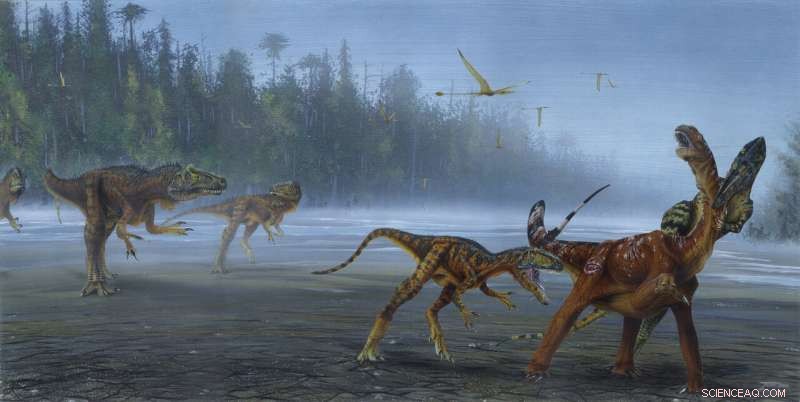
Allosaurus jimmadseni valt juveniele sauropod aan. Krediet:Todd Marshall
Een opmerkelijke nieuwe soort vleesetende dinosaurus is onthuld in het Natural History Museum of Utah. Paleontologen hebben het eerste exemplaar begin jaren negentig opgegraven in het Dinosaur National Monument in het noordoosten van Utah. De enorme carnivoor bewoonde de uiterwaarden van het westen van Noord-Amerika tijdens de late Jura-periode, tussen 157-152 miljoen jaar geleden, waardoor het de geologisch oudste soort is van Allosaurus , die dateren van vóór het bekendere staatsfossiel van Utah, Allosaurus fragilis . De nieuw genoemde dinosaurus Allosaurus jimmadseni , werd vandaag aangekondigd in het open access wetenschappelijke tijdschrift PeerJ .
De soort behoort tot de allosauroïden, een groep van kleine tot grote, tweebenige vleesetende dinosaurussen die leefden tijdens het Jura en het Krijt. Allosaurus jimmadseni , beschikt over een aantal unieke eigenschappen, waaronder een korte smalle schedel met lage gezichtskammen die zich uitstrekken van de hoorns voor de ogen naar voren naar de neus en een relatief smalle achterkant van de schedel met een plat oppervlak tot aan de onderkant van de schedel onder de ogen. De schedel was zwakker met minder overlappend gezichtsveld dan zijn jongere neef Allosaurus fragilis . Allosaurus jimmadseni evolueerde minstens 5 miljoen jaar eerder dan fragilis, en was de meest voorkomende en de beste predator in zijn ecosysteem. Het had relatief lange poten en staart, en lange armen met drie scherpe klauwen. De naam Allosaurus vertaalt als "ander reptiel, " en het tweede deel, jimmadseni, eert de paleontoloog James H. Madsen Jr. van de staat Utah.
Na een eerste beschrijving door Othniel C. Marsh in 1877, Allosaurus werd al snel de bekendste - inderdaad de ultieme - Jurassic theropod. De taxonomische samenstelling van het geslacht is de afgelopen 130 jaar lang een discussie geweest. Paleontologen beweren dat er ergens tussen de één en twaalf soorten zijn Allosaurus in de Morrison-formatie van Noord-Amerika. Deze studie herkent slechts twee soorten: A. fragilis en A. jimmadseni .
"Eerder, paleontologen dachten dat er maar één soort was Allosaurus in Jura Noord-Amerika, maar deze studie laat zien dat er twee soorten waren - de nieuw beschreven - Allosaurus jimmadseni evolueerde minstens 5 miljoen jaar eerder dan zijn jongere neef, Allosaurus fragilis , " zei mede-hoofdauteur Mark Loewen, onderzoeksmedewerker bij het Natural History Museum of Utah, en universitair hoofddocent bij de afdeling Geologie en Geofysica aan de Universiteit van Utah leidde het onderzoek. "De schedel van Allosaurus jimmadseni is lichter gebouwd dan zijn latere familielid Allosaurus fragilis , suggereert een ander voedingsgedrag tussen de twee."
"Het herkennen van een nieuwe dinosaurussoort in rotsen die al meer dan 150 jaar intensief zijn onderzocht, is een buitengewone ontdekkingservaring. Allosaurus jimmadseni is een goed voorbeeld van hoeveel we nog moeten leren over de wereld van dinosaurussen. Veel meer opwindende fossielen wachten op ontdekking in de Jurassic-rotsen van het Amerikaanse Westen, " zei Daniël Chure, gepensioneerd paleontoloog bij Dinosaur National Monument en co-hoofdauteur van de studie.
George Engelmann van de Universiteit van Nebraska, Omaha ontdekte aanvankelijk het eerste skelet van de nieuwe soort in het Dinosaur National Monument in 1990. In 1996, enkele jaren nadat het onthoofde skelet werd verzameld, de bij het skelet behorende radioactieve schedel met behulp van een stralingsdetector van Ramal Jones van de Universiteit van Utah. Zowel het skelet als de schedel werden opgegraven door teams van het Dinosaur National Monument.
"Grote Al, " een ander exemplaar dat tot de nieuwe soort behoort, werd in 1991 ontdekt in Wyoming op grond van het Bureau of Land Management (BLM) van de Verenigde Staten en is ondergebracht in de collecties van het Museum of The Rockies in Bozeman, Montana. Eerder gedacht te behoren tot Allosaurus fragilis , "Big Al" was te zien in de BBC-video "Walking with Dinosaurs:Ballad of Big Al" uit 2001. In de afgelopen 30 jaar, bemanningen van verschillende musea hebben materialen van deze nieuwe soort verzameld en voorbereid. Andere exemplaren zijn onder meer "Big Al Two" in het Saurier Museum Aathal in Zwitserland en Allosaurus materiaal uit de Dry Mesa Quarry of Colorado aan de Brigham Young University.
"Deze opwindende nieuwe studie illustreert het belang van voortgezet paleontologisch onderzoek op openbare gronden in het Westen. De ontdekking van dit nieuwe taxon van dinosauriërs zal belangrijke informatie opleveren over het leven en de tijden van Jura-dinosaurussen en vertegenwoordigt een ander uniek onderdeel van Amerika's erfgoed, zei Brent Breithaupt, BLM regionale paleontoloog.
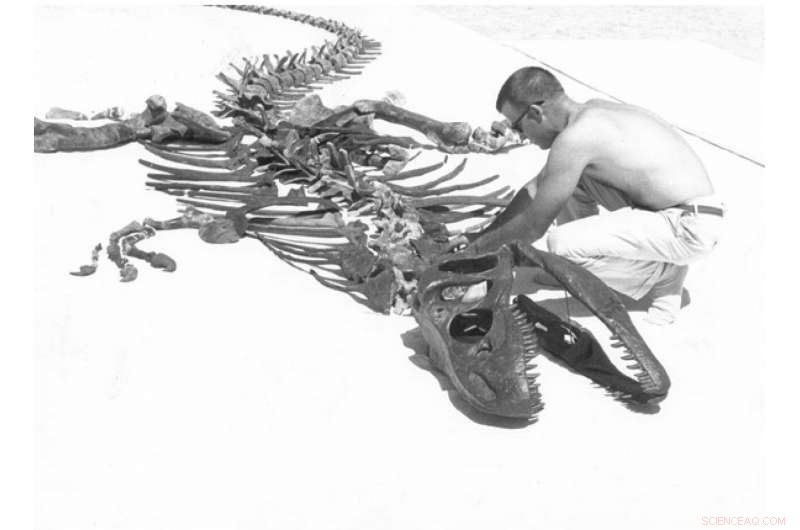
Paleontoloog James Madsen Jr assembleert een samengesteld skelet van Allosaurus uit de Clevland Lloyd Dinosaur Quarry Credit:J. Willard Marriot Library aan de Universiteit van Utah
Vroege Morrison Formation-dinosaurussen werden vervangen door enkele van de meest iconische dinosaurussen van het late Jura
Allosaurus jimmadseni leefde op de semi-aride uiterwaarden van Morrison Formation in het binnenland van West-Noord-Amerika. De oudere rotsen van de Morrison Formation behouden een fauna van dinosaurussen die verschilt van de iconische jongere Morrison Formation-fauna's, waaronder Allosaurus fragilis , Diplodocus en Stegosaurus. Paleontologen hebben onlangs vastgesteld dat exemplaren van deze nieuwe dinosaurussoort op verschillende plaatsen in het westelijke binnenland van Noord-Amerika leefden (Utah, Colorado en Wyoming).
Studie samenvatting
Dinosaurussen waren de dominante leden van terrestrische ecosystemen tijdens het Mesozoïcum. Echter, het patroon van evolutie en omzet van ecosystemen tijdens het midden Mesozoïcum blijft slecht begrepen. De auteurs rapporteren de ontdekking van het vroegste lid van de groep van grote allosauroïden in het Morrison Formation-ecosysteem dat werd vervangen door Allosaurus fragilis en illustreer veranderingen die in de loop van de tijd in het geslacht zijn verworven. De studie omvat een diepgaande beschrijving van elk bot van de schedel en vergelijkingen met de schedelmaterialen van andere vleesetende dinosaurussen. Eindelijk, de studie herkent slechts twee soorten Allosaurus in Noord-Amerika met Allosaurus fragilis ter vervanging van zijn eerdere familielid Allosaurus jimmadseni .
Factsheet:belangrijkste punten van de paper
- Een opmerkelijke nieuwe soort vleesetende dinosaurus, Allosaurus jimmadseni , wordt beschreven aan de hand van twee spectaculair complete skeletten. Het eerste exemplaar werd opgegraven in Dinosaur National Monument, in het noordoosten van Utah.
- Allosaurus jimmadseni onderscheidt zich door een aantal unieke kenmerken, waaronder lage toppen die van boven de ogen naar de snuit lopen en een relatief smalle achterkant van de schedel met een plat oppervlak tot aan de onderkant van de bovenste schedel onder de ogen. The skull was weaker with less of an overlapping field of vision than its younger cousin Allosaurus fragilis .
- At 155 million years old, Allosaurus jimmadseni is the geologically-oldest species of Allosaurus predating the more well-known State Fossil of Utah Allosaurus fragilis .
- Allosaurus jimmadseni was the most common and the top predator in its ecosystem. It had relatively long legs and tail, and long arms with three sharp claws.
Study design
- Comparison of the bones with all other known allosauroid dinosaurs indicate that the species possessed unique features of the upper jaw and cheeks (maxilla and jugal) and a decorative crest stretching from just in front of the eyes to the nose.
- Many of the comparisons were made with the thousands of bones of Allosaurus fragilis collected from the famous Cleveland-Lloyd Dinosaur Quarry administered by the Bureau of Land Management that are housed in the collections of the Natural History Museum of Utah.
- On the basis of these features, the scientific team named it a new genus and species of dinosaur, Allosaurus jimmadseni (translating to "Jim Madsen's different reptile").
- Allosaurus jimmadseni is particularly notable for its slender, narrow skull with short sharp nasal crests compared to its close relative and successor Allosaurus fragilis .
- The study was funded in part by the University of Utah, the National Park Service and the National Science Foundation.
New dinosaur name: Allosaurus jimmadseni
- The first part of the name, Allosaurus , (a·luh·SAW·ruhs) can be translated from Greek as the "other", "strange" or "different" and "lizard" or "reptile" literally to "different reptile". The second part of the name jimmadseni (gym-MAD-sehn-eye) honors the late Utah State Paleontologist James Madsen Jr. who excavated and studied tens of thousands of Allosaurus bones from the famous Cleveland-Lloyd Dinosaur Quarry in central Utah and contributed greatly to the knowledge of Allosaurus .
Size
- Allosaurus jimmadseni was approximately 26 to 29 feet (8-9 meters) long.
- Allosaurus jimmadseni weighed around 4000 lbs. (1.8 metric tonnes).
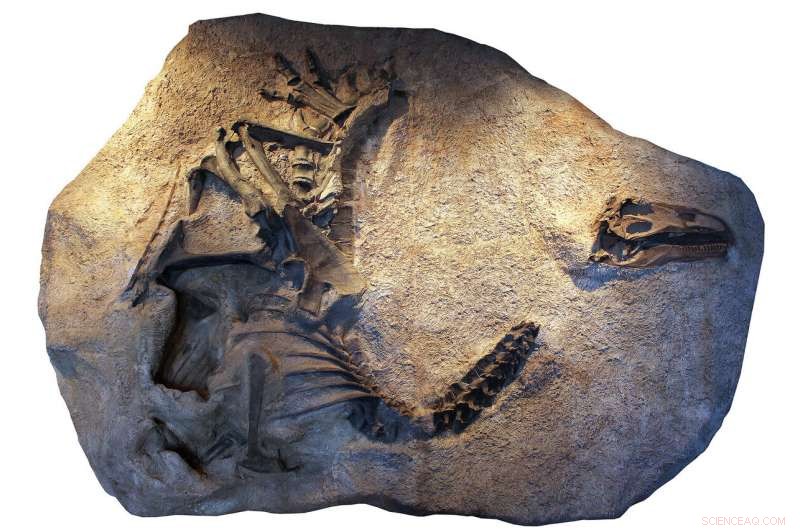
A cast of the skeleton and skull of Allosaurus jimmadseni as it was discovered and now on exhibit at Dinosaur National Monument in Utah. The original skeleton was molded and cast before it was taken apart and prepared for study and research. Credit:Dan Chure
Relationships
- Allosaurus jimmadseni belongs to a group of carnivorous dinosaurs called "allosauroids, " the same group as the famous Allosaurus fragilis .
- Other dinosaurs found in rocks containing Allosaurus jimmadseni include the carnivorous theropods Torvosaurus and Ceratosaurus; the long-necked sauropods Haplocanthosaurus and Supersaurus; and the plate-backed stegosaur Hesperosaurus.
- Allosaurus jimmadseni is closely related to the State Fossil of Utah, Allosaurus fragilis .
Anatomie
- Allosaurus jimmadseni was a two-legged carnivore, with long forelimbs and sharp, recurved claws that were likely used for grasping prey.
- Like other allosauroid dinosaurs, Allosaurus jimmadseni had a large head full of 80 sharp teeth. It was also the most common carnivore in its ecosystem.
Age and geography
- Allosaurus jimmadseni lived during the Kimmeridgian stage of the Late Jurassic period, which spanned from approximately 157 million to 152 million years ago.
- Allosaurus jimmadseni lived in a semi-arid inland basin filled with floodplains, braided stream systems, meren, and seasonal mudflats along the western interior of North America.
- Allosaurus jimmadseni represents the earliest species of Allosaurus in de wereld.
Ontdekking
- Allosaurus jimmadseni can be found in a geologic unit known as the Salt Wash Member of the Morrison Formation and its equivalents exposed in Colorado, Wyoming, and Utah.
- The first specimen of Allosaurus jimmadseni was discovered in the National Park Service administered by Dinosaur National Monument in Uintah County, near Vernal, Utah.
- Allosaurus jimmadseni was first discovered by George Engelmann of the University of Nebraska, Omaha on July 15, 1990 during a contracted paleontological inventory of the Morrison Formation of Dinosaur National Monument.
- Another specimen of Allosaurus jimmadseni known as "Big Al, " was found on land administered by the U.S. Department of the Interior's Bureau of Land Management in Wyoming.
- Further specimens of Allosaurus jimmadseni have been subsequently recognized in the collections of various museums.
- Allosaurus jimmadseni specimens are permanently housed in the collections of Dinosaur National Monument, Utah; the Museum of the Rockies, Bozeman, Montana; the Saurier Museum of Aathal, Switzerland; the South Dakota School of Mines, Rapid City, South Dakota; Brigham Young University's Museum of Paleontology, Provo, Utah; and the United States National Museum (Smithsonian) Washington D.C.
- These discoveries are the result of a continuing collaboration between the Natural History Museum of Utah, the National Park Service, and the Bureau of Land Management.
Excavation
- The first skeleton of Allosaurus jimmadseni was excavated during the summers of 1990 to 1994 by staff of the National Park Service's Dinosaur National Monument. The skeleton block was so heavy it required the use of explosives to remove surrounding rock and a helicopter to fly out the 2700 kg block. The head of the skeleton was missing
- The first bones of Allosaurus jimmadseni discovered included toes and some tail vertebrae. Later excavation revealed most of an articulated skeleton missing the head and part of the tail.
- The radioactive skull of the first specimen of Allosaurus jimmadseni , which had previously eluded discovery, was found in 1996 by Ramal Jones of the University of Utah using a radiation detector.
Preparation
- It required seven years to fully prepare all of the bones of Allosaurus jimmadseni .
- Much of the preparation was done by then Dinosaur National Monument employees Scott Madsen and Ann Elder, with some assistance from Dinosaur National Monument volunteers and students at Brigham Young University.
Ander
- The Natural History Museum of Utah houses the world's largest collection of Allosaurus fossielen, which are frequently studied by researchers from around the world.
- More than 270 National Park Service (NPS) areas preserve fossils even though only 16 of those were established wholly or in part for their fossils. Fossils in NPS areas can be found in the rocks or sediments of a park, in museum collections, and in cultural contexts (building stones, artifacts, historical legends, and documents).
- The United States Bureau of Land Management manages more land—247 million acres—than any other federal agency, and manages paleontological resources using scientific principles and expertise.
 Verborgen symmetrie gevonden in chemische kinetische vergelijkingen
Verborgen symmetrie gevonden in chemische kinetische vergelijkingen Wetenschappers ontdekken dat de chemie van zware elementen kan veranderen bij hoge druk
Wetenschappers ontdekken dat de chemie van zware elementen kan veranderen bij hoge druk Hoe maak je een Atom Arsenic Model
Hoe maak je een Atom Arsenic Model  Een gel die niet breekt of uitdroogt
Een gel die niet breekt of uitdroogt Nieuwe mechanismen voor verbetering van de activiteit van bimetaalkatalysatoren voor waterstofopwekking en brandstofcellen
Nieuwe mechanismen voor verbetering van de activiteit van bimetaalkatalysatoren voor waterstofopwekking en brandstofcellen
 Experts zeggen dat de uitbarsting van de Canarische Eilanden niet bijna ten einde is
Experts zeggen dat de uitbarsting van de Canarische Eilanden niet bijna ten einde is Hydraulisch breken heeft een negatieve invloed op de gezondheid van baby's
Hydraulisch breken heeft een negatieve invloed op de gezondheid van baby's Klimaatonderzoek heeft meer aandacht nodig voor menselijke populaties
Klimaatonderzoek heeft meer aandacht nodig voor menselijke populaties Vijf verschillende soorten abiotische factoren
Vijf verschillende soorten abiotische factoren  Politieke factoren bij migratie
Politieke factoren bij migratie
Hoofdlijnen
- Hoe handhaaft het plasmamembraan homeostase?
- Grootste genetische studie van muggen onthult verspreiding van resistentie tegen insecticiden in Afrika
- Hoe kan een babyrobotzeehond een medisch hulpmiddel zijn?
- Wat zijn de vier belangrijkste methoden voor het produceren van ATP?
- Hoe de hormonen van de hypofyse te onthouden
- Wat zijn de functies van co-enzymen?
- Wat zijn Twisted DNA-strengen in de kern van het cellichaam?
Desoxyribonucleïnezuur, of DNA, is het materiaal dat door de natuur wordt geselecteerd om de genetische code van de ene generatie van een soort naar de volgende over te brengen. Elke soor
- Studie onderzoekt obesitas en reproductieve status van dierentuinolifanten
- Dennen kappen:eerder vroeger dan later doen is beter voor fynbos
- Zwarte werknemers in de dienstverlenende sector betalen emotionele belasting op het werk

- Nieuwe statistieken kunnen de genderkloof in STEM-gebieden verkleinen
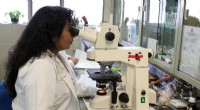
- Onderwijs verbetert de economische rationaliteit, studie vondsten
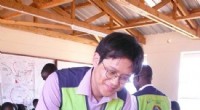
- Polygraaf leugendetectortests:kunnen ze echt voorkomen dat criminelen recidiveren?

- Wereldeconomie riskeert disruptie in de stijl van de jaren 70 in groene verschuiving

 Magnetische stormen:een venster op het verleden
Magnetische stormen:een venster op het verleden Instagram voert inspanningen op om desinformatie over COVID-19 te beteugelen
Instagram voert inspanningen op om desinformatie over COVID-19 te beteugelen Onderzoek toont drijvende factoren aan achter veranderingen tussen lokale en wereldwijde koolstofcycli
Onderzoek toont drijvende factoren aan achter veranderingen tussen lokale en wereldwijde koolstofcycli De ongelijkheid in moordcijfers in de buurten van Chicago nam in een periode van 20 jaar toe
De ongelijkheid in moordcijfers in de buurten van Chicago nam in een periode van 20 jaar toe Scans onthullen krantenpapier, tweede schilderij onder Picasso
Scans onthullen krantenpapier, tweede schilderij onder Picasso Oase-effect in stadsparken kan bijdragen aan de uitstoot van broeikasgassen, studie vondsten
Oase-effect in stadsparken kan bijdragen aan de uitstoot van broeikasgassen, studie vondsten Sky verwelkomt hoger bod van Comcast in strijd tegen Murdoch
Sky verwelkomt hoger bod van Comcast in strijd tegen Murdoch Krachtige laserdiodes kunnen restspanning in 3D-geprinte metalen onderdelen verminderen
Krachtige laserdiodes kunnen restspanning in 3D-geprinte metalen onderdelen verminderen
- Elektronica
- Biologie
- Zonsverduistering
- Wiskunde
- French | Italian | Spanish | Portuguese | Swedish | German | Dutch | Danish | Norway |

-
Wetenschap © https://nl.scienceaq.com

